Food Forensics: Detection of Hidden Toxins Present in Common Household Consumables
Manjunatha G and Fernandes Glorita Savia*
Department of Forensic Science, Jain University, India
Submission: August 19, 2018; Published: September 05, 2018
*Corresponding author: Fernandes Glorita Savia, Department of Forensic Science, Jain University, Bengaluru - 27, Karnataka, India.
How to cite this article:Fernandes G S, Manjunatha G. Food Forensics: Detection of Hidden Toxins Present in Common Household Consumables J Forensic Sci & Criminal Inves 2018; 10(4): 555791. DOI:10.19080/JFSCI.2018.10.555791.
Abstract
Food forensics is an emerging branch of forensic chemistry which comes to rescue when food is contaminated or adulterated. It helps to check food safety and quality amongst others. Food fraud in terms of adulteration is a growing problem in India. Every possible food item either raw or processed are often prone to adulteration. The present study was to identify common adulterant found in most common household consumables using simple chemical tests prescribed in the manual of Food Safety and Standards Authority of India (FSSAI). The 114 samples of 10 different food products both branded and locally available items were collected. The samples of ten different food items, i.e. Milk, Red chili powder, Tea leaves, Turmeric powder, Ghee, Honey, Pulse (yellow toor dal), Jaggery, Sugar and Asafoetida were tested. It was observed that locally available items that could be loosely purchased were particularly vulnerable to adulteration.
Keywords: Forensic Chemistry; Food Forensics; Adulterants; Presumptive test
Introduction
Forensic Chemistry uses the principles of chemical techniques to aid investigation agencies and law enforcement. In one such application, food forensics is a field of study under the forensic chemistry division and deals with the identification and analysis of illegalities in relation to food products or items of local consumption[]. Food being an important necessity for every living entity to obtain desired nourishment, is required for the sustenance of life. Adulteration can be defined as “An act of deliberately contaminating food material with inferior quality or cheap and inedible or toxic substances”[1,2]. Food adulteration may lead to chronic poisoning, various kinds of diseases and even fatality. Forensic studies with regards to food have not been a widely popular especially in India, where most of the cases of adulteration and testing are routinely carried out by the Food and Drug Administration [3-5]. Since the topic has a significance in the forensic field as well, this study was carried out to determine whether the current practice in place needs to be amended to elicit the criminal intentions of a few vendors or distributors and the rules if flouted by locally available items which finds its way into many homes across India[6].
The present study was conducted with the objective of detecting the presence of adulterants in commonly consumed household food items inclusive of both, packaged or branded and locally available or loosely sold items by presumptive color tests[7,8]. A total of 114 samples were studied which comprised of ten different food products i.e. ten samples of Milk, fourteen of Red Chili powder, ten of Tea Leaves, twelve of Turmeric powder, fourteen of Ghee, twelve of Honey, ten of a Pulse - Toor Dal (yellow), ten of Jaggery, twelve of Sugar and ten of Asafoetida (Hing). The potential toxins in each of them were detected by observation of color changes in the samples on performing prescribed tests as per the manual of Food Safety and Standards Authority of India (FSSAI).
Materials and Methods
a. Glassware: Test tubes, Test tube stands, Droppers and Glass rods.
b. Chemicals: Conc. HCl, Distilled water, Iodine solution, Conc. H2SO4, Ether, N-Hexane, Acetonitrile and Ethanol.
c. Miscellaneous: Lactometer, Red Litmus paper, Bunsen burner, Filter paper and Magnet.
The positive control samples for each adulterant was run side by side with the unknown samples. The unknown/test samples were randomly selected from both branded and local items. Minimum of 10 varieties of each ten different items were collected and tested using the appropriate chemical test methods[9].
Methodology/ Experiment/ Procedure
Each sample was measured and 5ml quantities were taken in each test tube[10]. The tests performed for the chemical examination of different adulterants have been illustrated in the tabular column given below Table 1.
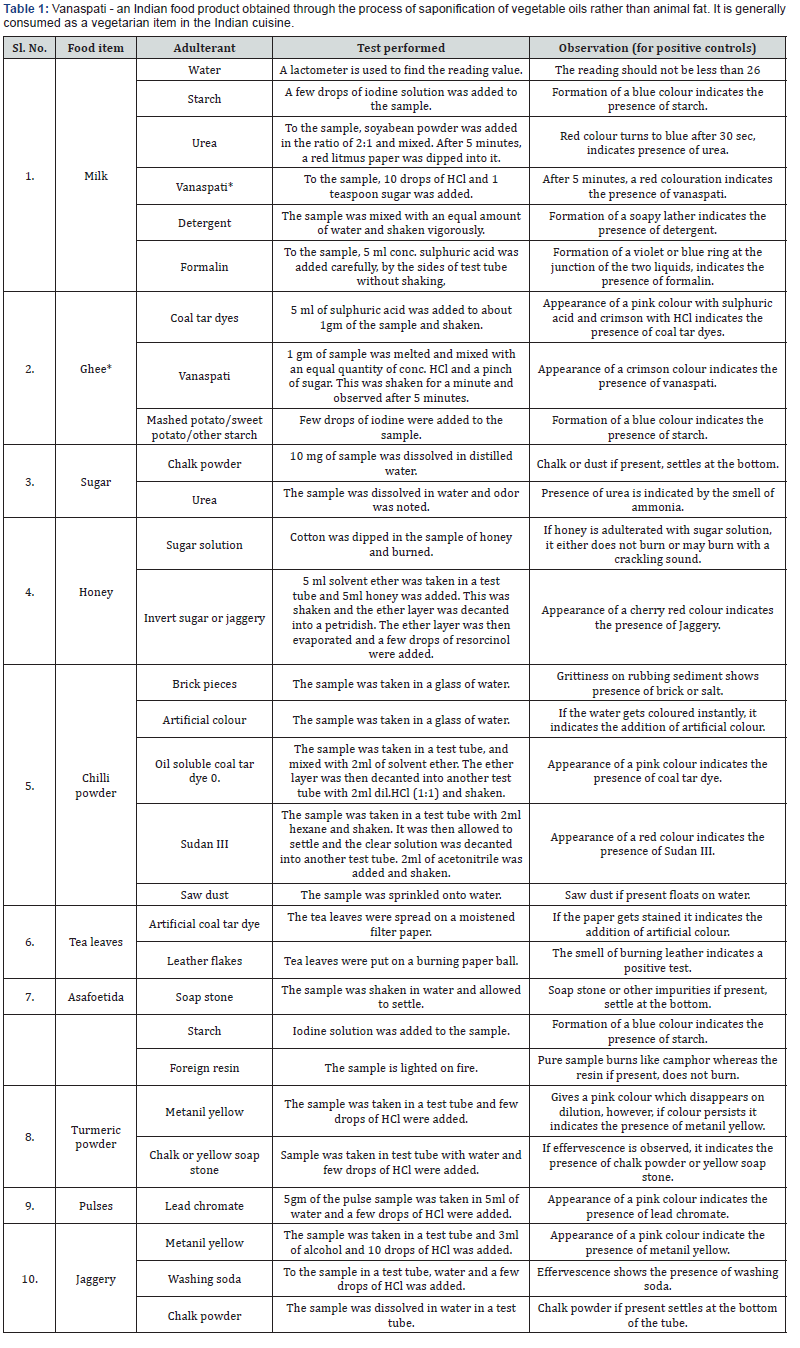
Results and Discussion/ Findings and Analysis
The observations were as given in the tabular columns below: Abbreviations used: -ve indicates a negative test result and +ve indicates a positive test result (Tables 2-11).
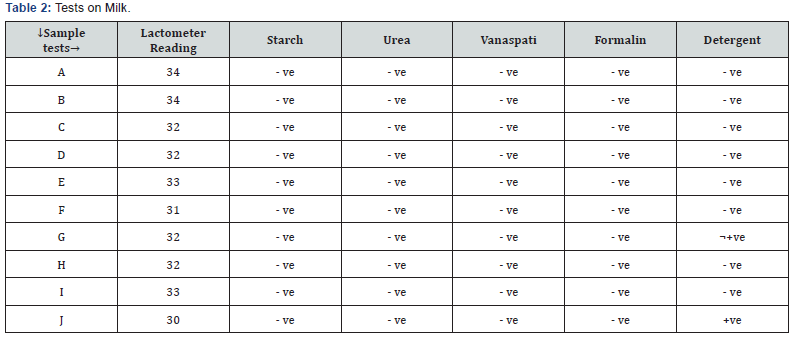
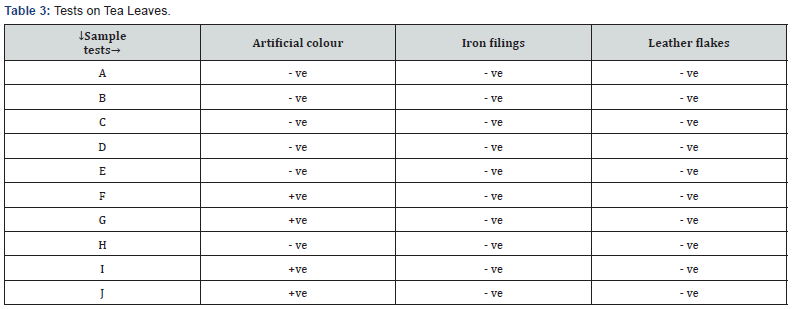
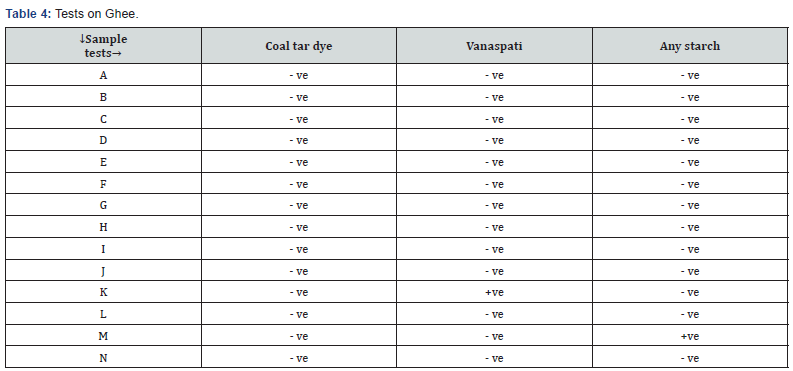
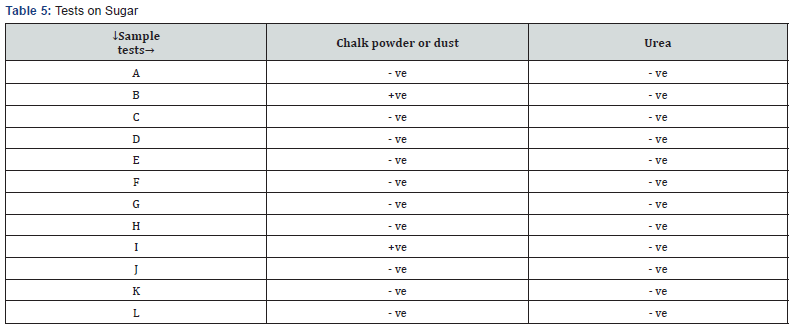
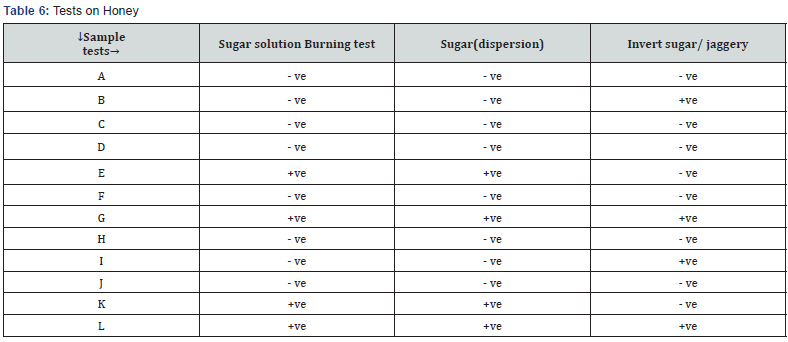
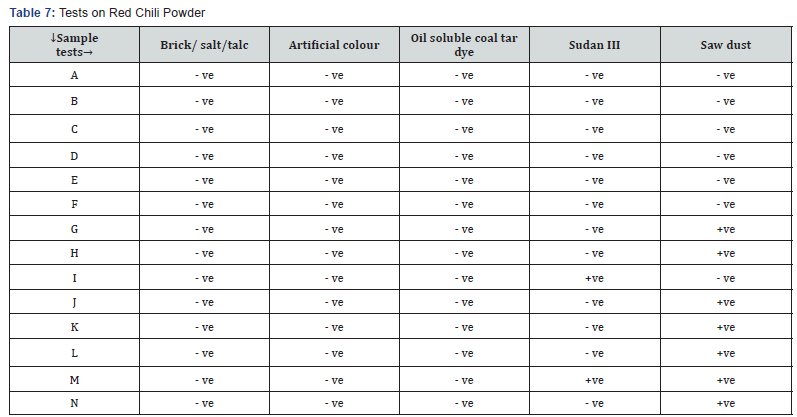
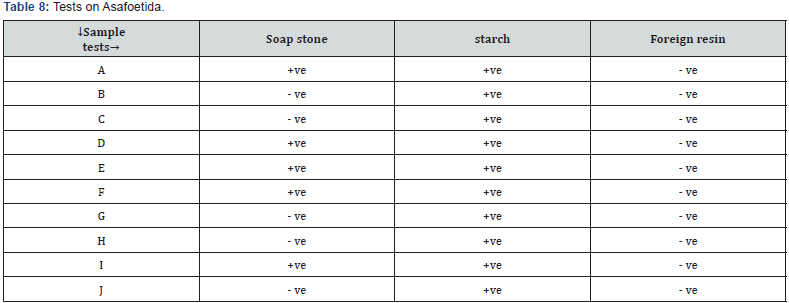
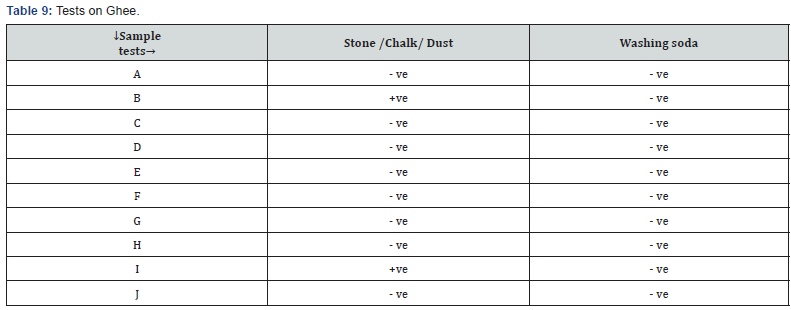
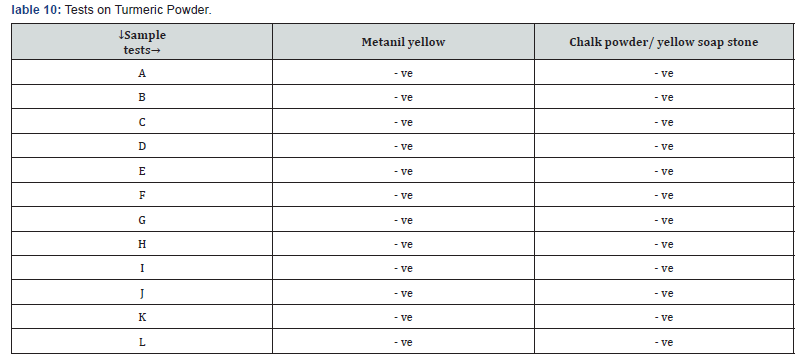
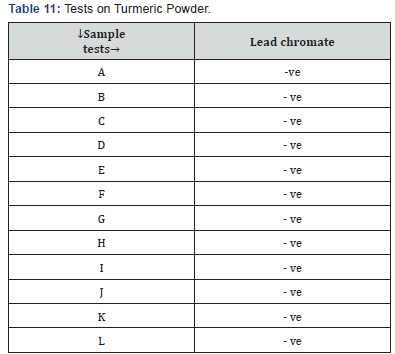
Conclusion
Based on our research, it was found that out of Ten different samples of milk, two milk samples showed presence detergent. Of the Eight samples of tea leaves, four samples indicated the presence of artificial colour. The two samples of chilli powder, out of Fourteen samples gave positive results for presence of Sudan III, and few showed presence of saw dust. Of the total Fourteen ghee samples tested, one showed presence of vanaspati and another showed presence of starch. One sample of pulses in the Ten samples tested showed presence of some unknown colour. Honey was found to be adulterated too, with four samples showed presence of sugar and presence of jaggery out of Twelve samples tested. Two samples of sugar showed presence of dust and chalk powder. The Ten tested samples of jaggery showed the presence of stone and chalk powder in five samples and washing soda was seen in two samples. Out of Ten samples of asafoetida tested, five positively indicated the presence of dirt and other impurities whereas all the ten samples showed presence of starch which may likely to have been due to addition of wheat flour during its processing. Hence on the whole, it was seen that the locally available items were more vulnerable to adulteration and since these items are more frequently purchased as compared to the costlier variants, it is the recommendation of this study that required measures should be enforced to check adulteration in the same.
Acknowledgement
Our sincere and heartfelt gratitude the Chairman, Vice- Chancellor, Director, Management, staff and laboratory members of Jain University, J. C. Road, Bengaluru for providing us with the necessary resources for the successful and timely completion of this research study.
References
- Royal Society of Chemistry (2016) Food Forensics.
- Stuart H James, Jon J Nordby (2005) Forensic Science: An Introduction to Scientific and Investigative Techniques (2nd edn,). CRC Press, USA.
- Ellis DI, Brewster VL, Dunn WB, Allwood JW, Golovanov AP, et al. (2012) Fingerprinting food: current technologies for the detection of food adulteration and contamination. Chemical Society Reviews 41(17): 5706-5727.
- (2016) United Kingdom Office of Public Sector Information. Food Safety Act 1990 (c.16).
- Adulteration in Food Stuff and Its Harmful Effects.
- (2016) Quick tests for some adulterants in food. Instruction manual part-II.
- Anita singh, Shuchi Rai Bhaitt, Sheeendra M Bhatt (2010) food adulteration and practices in urban areas of Varanasi.1(2): 183-195.
- Qin, Jianwei, Chao, Kuanglin, Kim (2015) Screening of adulterants in powdered foods and ingredients using line-scan Raman chemical imaging Science pp. 9488.
- Xie J, Wang DQ (2013) Textual research on adulteration of Chinese materiamedica in ancient China 43(5): 262-265.
- Deconinck E, Kamugisha A, Van Campenhout P, Courselle P, De Beer JO (2015) Development of a Stationary Phase Optimised Selectivity Liquid Chromatography based screening method for adulterations of food supplements for the treatment of pain 138: 240-246.






























